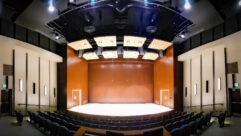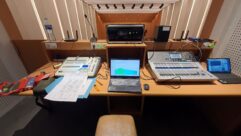It’s Intelligible, Charlie BrownRemember the “wha-wha, wha-wha” sound from your high-school days? The screech of feedback? This installation proves that even schools can have high intelligibility.
Feb 20, 1997 12:00 PM,
By Brian BlackmoreBlackmore is director of marketing services with Altec Lansing, Buchanan, MI.
School days – football games, homework, school plays and the prom. And do you remember how much feedback the principal would get during his speeches at those seemingly endless assemblies?
Brentwood Academy, a private high school outside of Nashville, decided its students would suffer no longer. The theater arts director, Jenny Wright, decided the sound system at the academy’s 500-seat Theater Arts Center should have new, powerful and flexible technology, technology able to serve all events held there: the two annual plays, the debates, the assemblies and the occasional concerts by the famous parents of some of the Brentwood students. And the bigger, better system would even be user-friendly and easy to operate.
Wright hired Southeastern Sound, Nashville, to provide a new sound-reinforcement system in conjunction with cosmetic improvements, such as stage curtains, room lighting and a reduction of the HVAC noise level.
Jon Hines of Southeastern Sound was the project manager. Brian Cook and Barry Birdwell were the project designers. The project architect was Nashville-based Earl Swensson, Associates. Stansell Electric, also of Nashville, was the electrical contractor.
Power and flexibilityKnowing the project had to be completed in time for the holiday theatrical production, Cook and Birdwell worked quickly. They used a three-channel (left, center, right) system design with the Altec-Lansing DTS series loudspeakers. These duplex coaxial loudspeakers physically align the high- and low-frequency drivers, creating a point-source device. In addition, their trapezoidal enclosures enable sound-system designers to put more loudspeakers in smaller spaces, increasing output and creating an effective point-source cluster.
The theater’s central loudspeaker array comprises three Altec-Lansing DTS642A-F 12 inch (305 mm) mid-high cabinets and one DTS182A dual 18 inch (457 mm) subwoofer cabinet. The left and right arrays include two of the DTS642A cabinets and one DTS 182A subwoofer. The Altec-Lansing sub-woofers accentuate the low-frequency output of the DTS loudspeakers, down to 31 Hz.
Cook and Birdwell had previously used the DTS system in a design they did for a large church venue in Virginia (see the sidebar, “Flexibility of Power”), which had proved to Birdwell that the DTS system could produce the speech intelligibility and music reproduction the theater department needed.
One key addition at the school was a simple rotary switch panel allowing the user to select up to seven preprogrammed modes of system operation for each independent array. With Altec-Lansing’s signal processing equipment, Brentwood Academy leapt into the future, bypassing darker ages when one equalizer setting had to meet all sound needs. Cook and Birdwell designed a detailed routing matrix using Altec-Lansing 4024 signal processors and Altec-Lansing 8431A programmable equalizers. By using one of these units for each program channel, they gained flexibility and fit the user controls with simple knobs. A program listing outlining the setting choices and system configurations was easily accessible, mounted inside the main equipment rack door. One setting mutes the left and right arrays to provide a speech-tailored equalization curve. Another setting provides music playback on all three arrays. Still another has speech on the center array with music playback on the left and right arrays with full bandwidth. Users can select the configuration that goes best with the current room use.
Mixing and productionThe Southeastern Sound designers were far from done. Wright wanted to put effects on the monitor mixes, and Birdwell and Cook found a quick way to get effects onto any bus she wanted. They set up the main sound mixer, a customized DDA interface, with a 40/4/4/2 layout. Microphone outlets around the stage were connected to the first 24 inputs. The 25th and 26th inputs were used to return effects from a Yamaha SPX 900 and a Lexicon Reflex effects unit. They also included a six-into-one input module for wireless microphones, along with four stereo input modules kept open for a Sony DTC A7 DAT player, Teac PCDP 4500 compact disc unit and a Denon DN 770R dual-cassette playback unit with pitch control.
They set up the four-channel output matrix to provide discrete feeds to the left, center and right loudspeaker arrays and an output feed to the lobby and “green room” distributed ceiling loudspeaker system.
Small events’ subsystemBoth Cook and Birdwell thought teachers and their students might have some problems working with a 40-channel mixer. To simplify mixing procedures, they created a small events’ subsystem comprising an Altec-Lansing 1700C mixer, a Teac PCDP 269 compact disc player and a Teac PW 750R cassette deck, which they put in an equipment rack adjacent to the stage. They installed a remote volume panel on the front of the stage so each input on the mixer could be controlled from the auditorium area. Finally, they combined the program output of this mixer with center channel output from the main mixing console by using a custom summing network, which allows the small events’ system to be used only through the center channel.
Added featuresA front-fill system installed in the face of the stage includes five Altec-Lansing M100 T loudspeakers that provide coverage for the area immediately in front of the stage, the orchestra and the first rows of the audience. A White 44.40 1/3 octave equalizer powered by a Crown CT-400 amplifier completes the front fill system. The signal routed to the front fill system loudspeakers is a summed matrix of each of the Altec-Lansing 4024 processors’ three channels. A separate four-channel monitoring system was set up for choir performances, musical stage productions and localized sound effects.
Last, but not least, a Burle TC 272-8 color video camera is mounted above the sound booth. The camera sends a video feed to a Sony CKV 20STD color monitor located in the “green room,” which, when coupled with the audio from the distributed sound system, helps performers to meet their cues by seeing and hearing the production in progress.
Cook and Birdwell are not given to hyperbole. You won’t hear them describe a system as having a “killer bottom-end” or “incredible mid-range punch.” But when they put together a system, they make sure it uses the latest technology to fulfill all the end-user’s needs.










